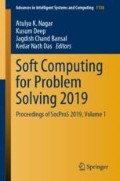Abstract
Particle swarm optimisation (PSO), one of the most elegant algorithms in the field of nature-inspired optimisation, has many variants for solving different types of problems. One of these variants is binary particle swarm optimisation (BPSO), which is suitable for solving combinatorial optimisation problems. A main component of BPSO is the transfer function that maps continuous velocity values to probability values which in turn are used to update particle positions. Transfer function has a significant impact on the performance of BPSO algorithm. This paper proposes a novel transfer function with tunable parameters that allows different U-shaped transfer functions. For evaluating the proposed transfer functions, a set of benchmark functions and 0/1 knapsack problems are employed. The results show that the U-shaped transfer functions can significantly improve the performance of BPSO. It is also shown that the BPSO algorithms equipped with U-shaped transfer functions provide superior results compared to the existing transfer functions in the literature.
Access this chapter
Tax calculation will be finalised at checkout
Purchases are for personal use only
References
L. Mason, J. Baxter, P.L. Bartlett, M.R. Frean, Boosting algorithms as gradient descent, in Advances in Neural Information Processing Systems (2000), pp. 512–518
D. Karaboga, B. Gorkemli, C. Ozturk, N. Karaboga, A comprehensive survey: artificial bee colony (ABC) algorithm and applications. Artif. Intell. Rev. 42(1), 21–57 (2014)
C. Wang, D. Mu, F. Zhao, J.W. Sutherland, A parallel simulated annealing method for the vehicle routing problem with simultaneous pickup–delivery and time windows. Comput. Ind. Eng. 83, 111–122 (2015)
S. Salcedo-Sanz, Modern meta-heuristics based on nonlinear physics processes: a review of models and design procedures. Phys. Rep. 655, 1–70 (2016)
I. BoussaïD, J. Lepagnot, P. Siarry, A survey on optimization metaheuristics. Inf. Sci. 237, 82–117 (2013)
J.H. Holland, Genetic algorithms. Sci. Am. 267(1), 66–73 (1992)
K. Fleetwood, An introduction to differential evolution, in Proceedings of Mathematics and Statistics of Complex Systems (MASCOS) One Day Symposium, 26th November, Brisbane, Australia (2004)
R. Storn, Kenneth Price, Differential evolution—a simple and efficient heuristic for global optimization over continuous spaces. J. Global Optim. 11(4), 341–359 (1997)
J. Knowles, D. Corne, The pareto archived evolution strategy: a new baseline algorithm for pareto multiobjective optimisation, in Proceedings of the 1999 Congress on Evolutionary Computation, 1999. CEC 99, vol. 1 (IEEE, 1999), pp. 98–105
J.R. Koza, Genetic Programming II, Automatic Discovery of Reusable Subprograms (MIT Press, Cambridge, MA, 1992)
Dan Simon, Biogeography-based optimization. IEEE Trans. Evol. Comput. 12(6), 702–713 (2008)
M. Dorigo, M. Birattari, Thomas Stutzle, Ant colony optimization. IEEE Comput. Intell. Mag. 1(4), 28–39 (2006)
J. Kennedy, Particle swarm optimization, in Encyclopedia of Machine Learning (Springer, Boston, MA, 2011), pp. 760–766
D. Karaboga, Bahriye Basturk, A powerful and efficient algorithm for numerical function optimization: artificial bee colony (ABC) algorithm. J. Global Optim. 39(3), 459–471 (2007)
Y. Shi, Particle swarm optimization. IEEE Connect. 2(1), 8–13 (2004)
R.C. Eberhart, Y. Shi, Comparing inertia weights and constriction factors in particle swarm optimization, in Proceedings of the 2000 Congress on Evolutionary Computation, 2000, vol. 1 (IEEE, 2000), pp. 84–88
I.C. Trelea, The particle swarm optimization algorithm: convergence analysis and parameter selection. Inf. Process. Lett. 85(6), 317–325 (2003)
M.A. Khanesar, M. Teshnehlab, M.A. Shoorehdeli, A novel binary particle swarm optimization, in Mediterranean Conference on Control & Automation, 2007. MED’07 (IEEE, 2007), pp. 1–6
J. Kennedy, R.C. Eberhart, A discrete binary version of the particle swarm algorithm, in 1997 IEEE International Conference on Systems, Man, and Cybernetics, 1997. Computational Cybernetics and Simulation, vol. 5 (IEEE, 1997), pp. 4104–4108
S. Mirjalili, Andrew Lewis, S-shaped versus v-shaped transfer functions for binary particle swarm optimization. Swarm Evol. Comput. 9, 1–14 (2013)
E. Rashedi, H. Nezamabadi-Pour, Saeid Saryazdi, BGSA: binary gravitational search algorithm. Nat. Comput. 9(3), 727–745 (2010)
Y. Shi, R.C. Eberhart, Empirical study of particle swarm optimization, in Proceedings of the 1999 Congress on Evolutionary Computation, 1999. CEC 99, vol. 3 (IEEE, 1999), pp. 1945–1950
M. Molga, C. Smutnicki, Test Functions for Optimization Needs (2005), p. 101
M. Jamil, X.-S. Yang, A literature survey of benchmark functions for global optimisation problems. Int. J. Math. Model. Numer. Optim. 4(2), 150–194 (2013)
S. Saremi, S. Mirjalili, A. Lewis, How important is a transfer function in discrete heuristic algorithms. Neural Comput. Appl. 26(3), 625–640 (2015)
J.C. Bansal, K. Deep, A modified binary particle swarm optimization for Knapsack problems. Appl. Math. Comput. 218(22), 11042–11061 (2012)
Author information
Authors and Affiliations
Corresponding author
Editor information
Editors and Affiliations
Appendix
Appendix
1.1 Unimodal Test Functions
1.2 Multi-modal Test Functions
See Table 5 for details of the test functions.
Rights and permissions
Copyright information
© 2020 Springer Nature Singapore Pte Ltd.
About this paper
Cite this paper
Mirjalili, S., Zhang, H., Mirjalili, S., Chalup, S., Noman, N. (2020). A Novel U-Shaped Transfer Function for Binary Particle Swarm Optimisation. In: Nagar, A., Deep, K., Bansal, J., Das, K. (eds) Soft Computing for Problem Solving 2019 . Advances in Intelligent Systems and Computing, vol 1138. Springer, Singapore. https://doi.org/10.1007/978-981-15-3290-0_19
Download citation
DOI: https://doi.org/10.1007/978-981-15-3290-0_19
Published:
Publisher Name: Springer, Singapore
Print ISBN: 978-981-15-3289-4
Online ISBN: 978-981-15-3290-0
eBook Packages: Intelligent Technologies and RoboticsIntelligent Technologies and Robotics (R0)

